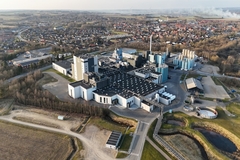
- Industry news
Industry news
- Category news
Category news
- Reports
- Key trends
- Multimedia
- Journal
- Events
- Suppliers
- Home
- Industry news
Industry news
- Category news
Category news
- Reports
- Key trends
- Multimedia
- Events
- Suppliers
Food out of thin air: Alt-protein grown with CO2 & electricity gets Singapore novel food regulatory approval
.png)
26 Oct 2022 --- A microbial protein-rich powder containing all the essential amino acids and tipped as one of the most significant alternative proteins for future food has received approval to be used across various food applications in Singapore. This greenlight paves the way for further approvals worldwide, according to Pasi Vainikka, the scientist behind Solein, who speaks with FoodIngredientsFirst about the regulatory “breakthrough.”
The regulatory approval for the novel food, given by the Singapore Food Agency (SFA), allows for the sale of food products containing Solein. The highly sustainable protein is planned to begin commercial production and sales in 2024.
.png) Pasi Vainikka, the scientist behind Solein and the Solar Foods’ CEO (Credit: Solar Foods).Finnish food-tech company Solar Foods submitted a novel food dossier on Solein for SFA’s consideration in September 2021.
Pasi Vainikka, the scientist behind Solein and the Solar Foods’ CEO (Credit: Solar Foods).Finnish food-tech company Solar Foods submitted a novel food dossier on Solein for SFA’s consideration in September 2021.

Solar Foods’ first commercial-scale production facility, Factory 01, is set to begin operations in Finland in 2024.
“This is an amazing achievement by our team. It is a multidisciplinary scientific endeavor to achieve something like this,” Vainikka, Solar Foods CEO, says.
“For all food-tech companies and the industry, there is one binary external risk for business, and it is regulatory approval. Having achieved this is important for us but also for the whole venture capital industry in the food tech space and our colleague companies.”
“We have submitted Singapore but also many other countries and regions and are aiming to be global, of course. However, the Singapore regulatory process is just so strategically focused and efficient.”
Commercialization on the cards
Although there are no specific details on product launches, Vainikka confirms that Solein can be used to replace existing proteins in various foods, for example, in alternative dairy and meat, different snacks and beverages, noodles and pasta, or breads and spreads.
.png) Solein is produced using a bioprocess, where microbes are fed with gasses and small amounts of nutrients (Credit: Solar Foods).
Solein is produced using a bioprocess, where microbes are fed with gasses and small amounts of nutrients (Credit: Solar Foods).
Solein is produced using a bioprocess, where microbes are fed with gasses and small amounts of nutrients.
Solein can be used with a wide variety of other ingredients: it vanishes into foods and doesn’t change the taste of familiar, everyday food products.
“It is the first-ever novel food disconnected from the limits of traditional agriculture. This type of production method has the potential to transform the sustainability, availability and transparency of what we eat and where food can be produced,” he says.
Capturing CO2
Solein is produced using a bioprocess, where microbes are fed with gasses (carbon dioxide, hydrogen and oxygen) and small amounts of nutrients.
Vainikka explains how the bioprocess resembles winemaking, with carbon dioxide and hydrogen replacing sugar as the source of carbon and energy.
Solein is 65-70% protein, 5-8% fat, 10-15% dietary fibers and 3-5% mineral nutrients.
The macronutrient composition of Solein cells is very similar to that of dried soy or algae. It provides iron and B vitamins and is considered “exceptionally functional.”
The production of Solein is not reliant on agriculture, weather or climate; it can be produced in harsh conditions such as deserts, arctic areas and even space. The process does not require animals or photosynthetic plants.
“Solein can help food innovators, manufacturers and brands overcome environmental impacts. It can help them to reach Environmental, Social, and Governance targets, food safety, security of supply, price hedging, quality fluctuations and some nutritional deficits,” Vainikka continues.
“We are constructing our first commercial factory in Finland, Factory 01. We expect it to supply in 2024. Before that, we may see Solein surfacing on the market through our pilot production.”
Solar Foods plans to seek GRAS (Generally Recognized As Safe) status assessment for Solein soon in the US, and applications for novel food authorization have been filed earlier in other key markets like the UK and the EU.
By Gaynor Selby










